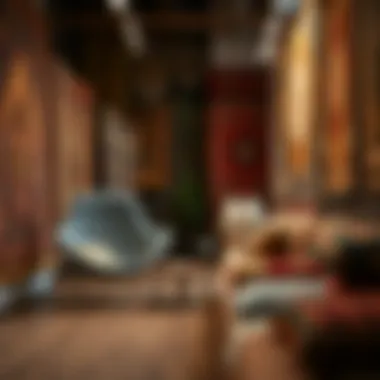Transform Your Space with Tapestry: A Complete Guide


Intro
Tapestry has woven its way through history, rich with stories as colorful as the textiles themselves. From the medieval tapestries that adorned castles to the modern fabric art that graces contemporary homes, the journey of tapestry is as intricate as the pieces themselves. It’s not just a decorative accessory; it’s a medium that gives character to any living space.
As we delve into the world of tapestry, we uncover its multifaceted role in room decor. Tapestries add warmth, texture, and an unmistakable charm to interiors. They allow individuals to express their unique style while serving practical purposes, such as insulation and sound absorption.
When considering ways to elevate your space, tapestry taps into a rich tradition while perfectly fitting into today’s aesthetic demands. From varying materials to an array of styles, the versatility of tapestry is remarkable.
As the guide unfolds, we will examine notable contemporary fashion trends, offer insightful style tips, and look at practical considerations like placement, maintenance, and sourcing. By the time you’ve finished reading, you will have a thorough understanding of how to harness the power of tapestry to transform your surroundings into a personalized haven.
Intro to Tapestry in Room Decor
When thinking about elevating room decor, tapestry often doesn’t come to mind at first glance, yet it has a profound role in transforming spaces. Tapestry serves not just as a visual element, but also as a storytelling device, enveloping a room in rich textures and cultural narratives. Unlike mass-produced wall art, tapestries imbue a sense of history and warmth that can redefine an atmosphere.
Throughout this guide, we will delve into the various facets of tapestry, exploring its benefits and the significant considerations for incorporating these rich textiles into modern design. With the surge in interest for unique and meaningful decor elements, understanding tapestry in this context is not only relevant but essential.
One of the main advantages of tapestry is its versatility. They can act as statement pieces, wall hangings, or even room dividers. Furthermore, the materials used to create tapestries - from wool to silk - contribute to their aesthetic and acoustic properties, providing a cozy ambiance while dampening noise in larger spaces. This is particularly important for those looking to create serene environments at home or in workplace settings.
Tapestries can easily complement or contrast with existing color schemes, offering depth and interest to a room. When well-placed, they guide the eye and can elevate the perceived sophistication of a space.
Understanding tapestry better allows stylists, designers, and retailers to market unique pieces more effectively while educating clients about their history and significance, thus making their designs richer. A tapestry is not simply a decorative item; it is a narrative encapsulatd in textile that deserves to have a place in contemporary interiors.
"A tapestry is like a canvas for life stories, weaving in color and texture what words often cannot convey."
Understanding Tapestry: A Historical Perspective
The art of tapestry has a long and winding history, echoing the textures of human civilization itself. For centuries, tapestries were not just household items; they were symbols of wealth and power. In the Middle Ages, nobility adorned their castles with tapestries depicting grand scenes, often illustrating battles, myths, or pastoral settings. These textile narratives served both functional and aesthetic purposes—insulating cold stone walls while also captivating visitors with their intricate designs.
As craftsmanship evolved, so did the significance of tapestries. By the Renaissance, artists began influencing tapestry designs, collaborating with weavers to render paintings into elaborate woven pieces. The famed Gobelins Manufactory in France is a prominent example where this marriage of art and utility flourished.
The storytelling aspect of tapestries is profound; each design is an encapsulation of the era it hails from and the stories it conveys. They act as historical records, capturing nuances of life at the time—a vibrant documentation of culture and experience, which is often overlooked in today’s fast-paced world. Understanding this journey through history not only adds depth to the tapestry itself but also enhances its appeal as a design choice.
The Resurgence of Tapestry in Contemporary Design
Fast forward to today, and tapestry is experiencing a renaissance. In an era that's saturated with digital imagery and disposable decor, many individuals are yearning for tactile and meaningful elements in their living spaces. Tapestries are no longer confined to the walls of aristocratic homes; they are cropping up in trendy urban apartments and cozy cottages alike. This trend is fueled by a desire for authenticity and individuality.
Interior designers are embracing tapestry not just for its aesthetic value, but also for its functionality. In open-concept living spaces, tapestries serve as natural dividers, creating an illusion of separate zones without permanent installations. This fluidity speaks to contemporary lifestyles that often require flexibility in design.
Moreover, the modern tapestry is constantly evolving, with artists experimenting with bold colors, abstract patterns, and contemporary themes. From oversized pieces that become the focal point of a room to smaller artworks that can be grouped together, they offer limitless possibilities for personal expression. Homeowners are beginning to view tapestries not just as decorative pieces, but as crucial components that can enhance their home’s narrative and character.
Types of Tapestry: A Diverse Array
In the world of interior design, the choice of tapestry is not just a matter of aesthetics; it also reflects cultural narratives and artisanal craftsmanship. Tapestries, with their rich fabric and intricate designs, can elevate any space into a visual narrative that mirrors personal style or even collective history. Understanding the various types of tapestries allows stylists and designers to curate spaces that resonate with both character and sophistication. This broad spectrum of tapestry can cater to different tastes and functional needs in home decor, making it essential to explore in detail.
Woven Tapestries: Craftsmanship and Artistry
Woven tapestries represent ancient craftsmanship, where threads intertwine to tell stories or showcase artistry. Each piece is often unique, showcasing the skill of artisans who weave with care and intention. The intricate patterns found in woven tapestries often promote a sense of depth and texture that printed versions cannot replicate. Such craftsmanship can bring warmth and personality to a room.
These tapestries may be created using traditional techniques passed down through generations. The materials range from wool to silk, each offering distinctive qualities that affect the overall feel and durability of the piece. For instance, wool woven tapestries tend to be more resilient, making them suitable for high-traffic areas, while silk options may serve better as statement pieces in more delicate spaces.
"A woven tapestry can turn a dull wall into a rich storytelling canvas, adding life and warmth to the environment."
When considering a woven tapestry, think about the story it tells, the skill behind it, and how well it can enhance a space creatively and aesthetically. These pieces can often serve as the focal point of a room, drawing the eye and inviting conversation.
Printed Tapestries: A Modern Take
Printed tapestries allow for vibrant designs and more economical options. These are often made from synthetic materials, which can accommodate unique prints and graphics. They bring a contemporary edge to classic interior themes, integrating modern art concepts into fabric design.
The beauty of printed tapestries lies in their versatility. Styles can shift from abstract to botanical imagery, providing a disengagement from traditional motifs. They can also be easier to clean and maintain, making them practical for families or those who prefer lower upkeep in their decor. Additionally, printed options can be themed more easily, suitable for seasonal changes or creative expressions in various environments.


Designers can explore bold colors and contemporary art styles through these tapestries, making them an appealing choice for those who wish to play with visual art in their decor. With accessibility to endless patterns, this form invites a fun integration of modern motifs into any room.
Macrame and Textile Arts: Alternative Textures
Tapestry doesn't solely rely on woven or printed fabric; it can also transcend traditional definitions through macrame and other textile arts. This craft, which uses knotting techniques to form intricate patterns, offers a tactile experience absent in typical textiles. Macrame pieces can range from wall hangings to more functional items like plant holders.
The organic textures produced in macrame add a bohemian flair to spaces and speak to a more handmade aesthetic. This approach to tapestry often appeals to those who seek a connection to artisanal practices in their decor, engendering a sense of authenticity. Using natural fibers like cotton or hemp enhances the earthy feel and sustainability aspect.
These pieces can easily blend into a variety of decor styles, whether they complement minimalism or add depth to eclectic spaces. Macrame can serve as a focal point, or alternatively, as a subtle background element that enriches the visual landscape without overwhelming it.
By exploring the diverse tapestry types, you're not just choosing decor; you’re weaving in history, modernity, and artistry while making thoughtful decisions that contribute meaningfully to your space.
Designing with Tapestry: Aesthetic Considerations
Designing with tapestry involves more than just hanging fabric on the wall. It presents an opportunity to converge art and function in a way that enhances overall decor while expressing personal style and flair. Tapestries can serve as bold statements or subtle backgrounds, depending on how they are incorporated into the living space. Crafting a cohesive environment necessitates an understanding of aesthetic principles, particularly concerning color, patterns, and themes.
Color Schemes: Complementing Your Interior Palette
When you think about color schemes in tapestry, imagine a spectrum of possibilities. Each color evokes certain emotions, and how you combine them can transform a space. For instance, a vibrant tapestry featuring citrus hues can infuse energy into a room, while soft, muted tones can have a calming effect. This makes color selection paramount when choosing how to adorn your walls with tapestry.
- Contrast and Harmony: Consider the colors on your walls and other decor elements. A tapestry that contrasts beautifully with the existing palette can serve as a focal point, attracting attention without overwhelming the viewer. For example, a tapestry with jewel tones can pop against a neutral backdrop, making every detail stand out.
- Color Wheel Guidance: Understanding the basics of the color wheel can also guide your selections. Analogous colors (those next to each other on the wheel) create a harmonious feel, while complementary colors (those across from each other) bring a dynamic balance to the space.
To make informed choices, gather paint samples from your walls and compare them against potential tapestry options. This way, you ensure that the tapestry you choose not only fits but elevates the overall aesthetic of your interior.
Patterns and Themes: Expressing Individuality
Patterns and themes in tapestry do more than decorate walls; they tell stories, evoke memories, and reflect cultures. These elements offer a fantastic canvas for individual expression. When selecting tapestry, think about what resonates with you personally, as well as how it communicates the essence of the space.
- Narrative Through Design: A tapestry featuring intricate, historical designs can spark conversations about its origin and representation. For instance, tapestries inspired by Art Deco or Moroccan influences can impart a unique character to contemporary or minimalist spaces.
- Personal Touch: Don't shy away from expressing your own story. Whether your aesthetic leans towards whimsical floral patterns, abstract geometry, or bold graphics, choose a tapestry reminiscent of your personality. If your home embraces nature, select a tapestry that showcases landscapes or wildlife, inviting the outdoors within your space.
A well-chosen tapestry can weave together various elements of a room, complementing furniture and decor in myriad ways. Ultimately, designing with tapestry is less about following trends and more about crafting a space that feels authentically yours.
"Each piece has a tale to tell, a story waiting to unfold. By choosing the right tapestry, you're not just adding decor—you're inviting a narrative into your home."
Thus, as you plan your interiors, think of tapestry not simply as an accessory but as an expressive medium; one that ligates the heart of your design choices with the soul of your individual style.
Placement of Tapestry: Maximizing Impact
The placement of tapestry is pivotal in transforming any room's atmosphere. It's not just about hanging a piece of fabric on the wall; it’s about how that fabric interacts with the space around it. The right tapestry can serve as a focal point that draws the eye and creates a dialogue within the room. Alternatively, it can serve as a subtle background, enhancing the existing elements without overwhelming them.
When considering tapestry placement, one must think about scale, color, and context. For instance, a large, vibrant tapestry can inject energy into a flat, muted room, while smaller, intricate pieces create a sense of intimacy and detail. Positioning these textiles thoughtfully allows for the creation of a unified aesthetic. Ultimately, the tapestry should resonate with the room's overall design narrative.
Key Benefits of Thoughtful Tapestry Placement:
- Establishes a focal point that captivates attention.
- Enhances visual interest, breaking up monotonous wall spaces.
- Affects the mood of the room—warmer colors evoke comfort, while cooler tones can create calmness.
- Provides an opportunity for personal expression, showcasing unique tastes in art or culture.
Wall Display: Focal Points and Backgrounds
Hanging tapestry on walls has immense potential for creating dramatic visual effects. When choosing a primary wall for display, consider walls that naturally draw the eye, like those behind sofas or beds. A tapestry here acts as a canvas, showcasing colors and narratives that set the tone for the room. To create a captivating focal point, think about the tapestry's dimensions relative to the wall. A piece that is too small can feel lost, while one that is too large might eclipse the rest of the decor.
Guidelines for Effective Wall Display:
- Height Matters: Hang the tapestry at eye level—roughly 57-60 inches from the floor—to ensure it’s easily viewed.
- Frame it Right: Consider using a decorative frame or rod to add structure and design elements.
- Group with Care: If incorporating multiple pieces, create a cohesive gallery wall that tells a story or relates through color.
"A well-placed tapestry can change the look, feel, and functionality of a space, shifting from background scenery to the spotlight of a room."
Incorporating Tapestry in Multi-functional Spaces
In contemporary living, spaces seldom serve a single purpose, leading to the need for decor that can adapt. Tapestries can be particularly effective in multi-functional areas like studios or open-concept living. They provide flexibility: when draped, they can divide spaces without permanently altering the layout. For example, a tapestry used as a partition can distinguish between relaxation and work zones elegantly.
Strategies for Incorporating Tapestry in Versatile Spaces:


- Creative Textiles: Choose materials and designs that can transition well between different functions—think lightweight and easily changeable.
- Mobility: Utilize tapestry rods or hooks that allow you to shift the fabric as needed. This adjustability makes it easy to refresh a room's look or adjust to a changing purpose.
- Layering Textures: Complement tapestries with furniture that echoes their colors or styles—for example, a soft sofa paired with a nature-themed tapestry creates a cohesive feel.
In summary, thoughtful placement of tapestry can significantly elevate the decor of a room, transforming it into a canvas of personality and function. With the right approach to display and integration within varied spaces, tapestries can deliver lasting aesthetic impact.
Maintenance and Care of Tapestry
Caring for tapestries is as crucial as selecting the right one in the first place. Their intricate designs and compositions not only tell stories but also require a bit of effort to maintain their beauty and integrity. Without proper care, these famed textile artworks can lose vibrancy or even suffer damage, which is every decor enthusiast's nightmare.
The attention to tinkering with maintenance really pays off, as it extends the life of these pieces and keeps them looking fresh. Think of it this way: if you wouldn't let a fine painting gather dust in the corner, why would you treat a tapestry any different? Understanding the maintenance techniques will empower you to preserve your tapestry's charm and significance.
"A well-maintained tapestry breaths life into a room, holding its history and artistry intact for future generations to admire."
Cleaning Techniques for Longevity
Keeping a tapestry clean doesn't have to feel like climbing a mountain; some straightforward techniques can keep the dust bunnies at bay. Dust accumulation is a natural enemy of textiles, leading to discoloration and deterioration over time.
- Regular Dusting: Using a soft brush or a vacuum with a gentle brush attachment every few weeks can remove accumulated dust. This way, you prevent buildups that, if left unchecked, might harm the fabric.
- Spot Cleaning: If accidents happen—like a spilled drink or a rogue pet hair—immediate action can often save the day. Gently blot the stained area with a damp cloth and a little mild soap. Avoid scrubbing, as it could ruin the fibers.
- Professional Cleaning: For pieces that are particularly valuable or those that haven't seen a cleaning in years, professional intervention might be necessary. Seek out a cleaner who has experience with delicate textiles.
- Avoid Direct Sunlight: Sunlight can fade even the most vibrant colors, so positioning your tapestry in a spot that doesn't get blasted by sunlight helps preserve its hues.
Storage Solutions: Preserving Quality
When the time comes to temporarily store a tapestry, how you do so can make all the difference. Improper storage can lead to creases, fading, and even pest issues. Here are practical tips for keeping your tapestries safe when they’re not on display:
- Roll, Don't Fold: Folding can lead to unsightly creases that become permanent. Instead, roll your tapestry around a tube covered in acid-free paper or fabric to protect it while storing.
- Temperature Control: Store tapestries in a climate-controlled environment, away from humidity and extreme temperatures. Basements or attics might be tempting, but they can harbor moisture or drastic temperature changes that harm the fabric.
- Use of Protective Covers: Consider wrapping your tapestry in breathable fabric. Plastic covers can trap moisture, leading to mildew, while breathable fabrics allow air circulation and help keep dust away.
- Regular Check-ups: If you're storing the tapestry for an extended period, check on it periodically. Make sure it’s still in good shape, and address any issues before they escalate.
Each of these maintenance techniques ensures that your tapestry remains an eye-catching feature in your home. Tapestries have a unique way of adding depth and personality to decor, and with some care, they can remain vibrant pieces of art for years to come.
Sourcing Quality Tapestries: Where to Find Them
Finding the right tapestry is not just about aesthetics; it also speaks volumes about your style and values. The importance of sourcing quality tapestries lies in the blend of artistry, craftsmanship, and cultural heritage embedded within these textiles. When choosing a tapestry, you want a piece that resonates with the atmosphere of your space and reflects your personality. Quality doesn’t merely denote superior materials; it encompasses the story behind the commissioning of each artwork and the skills of those who created it.
The benefits of carefully sourcing tapestries are manifold. High-quality pieces can elevate a room's decor, creating a conversation starter and a focal point of beauty. They often possess durability and striking designs that can stand the test of time. Moreover, selecting tapestries made by artisans or from reputable sources often ensures that you're supporting sustainable practices—an act that carries significance in today’s consumer landscape.
Artisan Markets and Handmade Options
Artisan markets and local craft fairs offer a treasure trove of unique tapestries; places where you can connect with designers and creators directly. Buying handmade tapestries not only supports artisans but also ensures that each piece has a unique story. Many of these craftsmen pour their heart and soul into their work, which typically reflects cultural significance, traditional techniques, and innovative design approaches.
When wandering through these markets, don’t hesitate to engage with the artisans. Ask about the inspiration behind their work, the techniques they used, and how they source their materials. Oftentimes, you'll discover that these pieces are more than mere decorations—they are embodiments of a particular culture or narrative. These interactions can provide you with valuable insight into the craftsmanship that goes into each piece, allowing you to appreciate your tapestry at a deeper level.
To help you get started, consider the following tips when looking at artisan markets:
- Research Local Events: Find out when artisan markets are held in your area. Websites like localharvest.org can help you find quality markets.
- Engage with the Artisans: They often have stories behind their crafts that enrich your purchase.
- Look for Certifications: Some artisans may have certified their works with quality labels, ensuring they meet certain standards.
Online Platforms: A World of Choices
If you're distance-challenged, the internet opens a vast world of options for sourcing tapestries. Websites such as Etsy and Artfinder offer platforms specifically tailored for artisans and independent creators. On these platforms, you can find an array of tapestries from all corners of the globe.
While sourcing online, keep in mind the merits of shopping with reputable sellers. Pay attention to customer reviews and ratings, which can provide invaluable insight into the quality you can expect.
Here are some things to consider when navigating online platforms:
- Quality Over Quantity: It's easy to get overwhelmed with choices, so focus on the quality of the items rather than the sheer number of options.
- Verify Seller Authenticity: Look for verified sellers to ensure you're not purchasing a reproduction but rather an original piece.
- Check Return Policies: Sometimes the tapestry that looks great online might not suit your space in reality. Understanding the seller's return policies can offer peace of mind.
By diligently sourcing quality tapestries from both local artisan markets and online platforms, you not only beautify your living space but also contribute to the preservation of craft traditions and support the arts. This combination of local and global approaches allows for a rich tapestry of cultural narratives to be woven into your home.
Tapestry as a Reflection of Culture
Tapestry, at its core, serves as more than just a decorative item. It is a vibrant canvas that tells the stories of cultures across the globe. The intricate patterns, textures, and hues woven into these textiles often embody the traditions, values, and historical narratives of the communities that produce them. When one brings a tapestry into a room, they are not merely enhancing the aesthetic appeal but also inviting a piece of history and culture into their living space.
Tapestry Traditions Across the Globe
Every nation’s tapestry reflects its unique heritage and artistry. For instance, the Bayeux Tapestry of France is a stunning piece that narrates the tale of the Norman Conquest of England. It stretches over 70 meters and is a remarkable example of storytelling through textile art. On the other hand, Persian tapestries, known for their intricate patterns and vivid colors, often depict scenes that celebrate nature and spirituality.


In South America, the Andean textiles woven by indigenous communities carry stories of their ancestors and traditional practices. Each pattern and color has significant meaning and is handed down through generations, ensuring that each piece holds not just beauty, but history.
Furthermore, African tapestries, rich in color and symbolism, often represent community values and social commentary. The materials used, like cotton or wool, may differ vastly, but the commitment to craftsmanship unites the artisans. This diversity paves the way for discussions about how societies connect through art, and how tapestry serves as a thread binding their cultural fabric together.
Cultural Narratives Embedded in Textile Art
The cultural narratives found in tapestry art often serve as a mirror reflecting societal beliefs and experiences. In many cultures, motifs and designs are laden with meaning. For example, in Native American textiles, the use of specific symbols can denote elements like community, nature, and spirituality, while also holding history within the fabric.
The storytelling aspect of tapestry is compelling. It acts as a cultural archive, preserving the stories of triumphs and tragedies. These pieces often become symbols of identity, encapsulating the essence of who people are and where they come from. The act of weaving itself is often imbued with ritual and tradition, transforming the process into a communal event celebrating shared heritage.
“Tapestries are the voice of the silent – they tell their tales without uttering a word.”
Additionally, modern tapestries sometimes tackle contemporary issues, blending old techniques with new perspectives. They challenge viewers to think about current social, environmental, and political climates, making them relevant in today’s world.
In summary, tapestry is not simply a decorative element. It unspools narratives of culture, emotion, and identity, offering a profound connection to our shared human experience. By choosing to incorporate tapestry in room decor, one elevates the space while honoring the stories and traditions of diverse cultures, creating an engaging dialogue that enriches our shared existence.
Personalizing Space with Tapestry
Personalizing a living space is akin to storytelling without words. It's about weaving your personality into the fabric of your home. This is where tapestry shines as a versatile decor element. Unlike mere wall paint or conventional art pieces, tapestries offer depth, texture, and narrative. They act like a canvas that reflects unique experiences, preferences, and cultural tales.
Tapestry can significantly benefit an interior by serving multiple purposes:
- Visual Interest: The intricate designs of tapestries can captivate attention and draw the eye.
- Warmth: They add a layer of comfort by softening acoustics in a space, creating a cozy atmosphere.
- Cultural Significance: Tapestries can tell stories tied to specific cultures or periods in history, inviting conversations about heritage.
When selecting a tapestry for personalization, consider the themes that resonate with you. Whether it evokes memories of travels or reflects an artistic preference, the right tapestry acts as an extension of self. Choosing one that aligns with your style can transform a room from mundane to extraordinary.
Storytelling Through Artwork
Art has the power to transport us, often evoking emotions or memories. With tapestry, storytelling takes on a tangible form. Each stitch and weave can narrate tales of a specific era, locality, or personal journey. Imagine a tapestry depicting a serene landscape or an intimate family gathering. Such imagery can instantaneously conjure feelings of nostalgia, celebrating moments that matter.
Tapestries can also serve as focal points in a room, guiding the viewer’s gaze toward crucial narratives. For example, a wall adorned with a large, vibrant tapestry can set the tone for the entire space, speaking volumes about your tastes and storyline.
When curating your tapestry collection, keep in mind the stories you wish to tell:
- Personal Memories: Represent significant life events or travels.
- Cultural Heritage: Choose designs that reflect your background or communities you cherish.
- Nature and Environment: Tapestries showcasing flora and fauna can evoke tranquility and connection to the world around you.
"Art is the most beautiful of all lies."
– Hans Christian Andersen
Layering with Other Decor Elements
Layering different decor elements can elevate the aesthetic appeal of a room. Tapestries, with their depth and texture, can blend seamlessly with various elements, like colors, furniture, or even lighting.
Here are ways to effectively layer tapestries with other decor:
- Contrasting Textures: Combine tapestries with smooth surfaces—like ceramic vases or sleek furniture—to create eye-catching contrasts.
- Accent Colors: Use colors from the tapestry in throw pillows, rugs, or other accessories to unify the design and create balance.
- Mix and Match Styles: Don’t shy away from combining various styles, like contemporary pieces with traditional tapestries, to create a unique blend.
- Unity in Theme: Ensure all elements in the room harmonize with the story the tapestry tells, enhancing the overall ambiance.
By thoughtfully layering different decor items in conjunction with tapestries, you create a cohesive narrative within your space. This approach not only showcases individuality but also celebrates the interplay of art and functionality in decor.
Incorporating tapestry art into your home is more than just decoration; it's about embodying your style and preferences, making your space a vivid reflection of who you are.
The End
In the sprawling landscape of interior design, tapestry holds a unique position that intertwines artistry and functionality. Its importance in the realm of room decor cannot be overstated. Through this guide, we’ve examined the historical roots of tapestry, and its revival in modern settings, illustrating how it serves as both a decorative element and a storytelling medium.
Embracing Tapestry as a Timeless Design Choice
When it comes to weaving personal narratives into our living spaces, tapestry emerges as an unparalleled choice. The beauty of tapestry lies in its versatility; whether woven or printed, these textile arts can easily adapt to various design paradigms. Here’s why embracing tapestry can transform a room:
- Rich Visual Texture: Tapestries provide depth that flat art pieces often miss. From intricate patterns to bold colors, they instantly draw the eye, setting the tone for the entire room.
- Cultural Significance: Each tapestry can reflect the culture it originates from, weaving stories of tradition and heritage into your decor. This not only adds a layer of sophistication but also challenges viewers to appreciate diverse aesthetics.
- Personal Touch: Tapestry is inherently personal. A piece that resonates with your journey or distills your passions can make an ordinary space uniquely yours. Just like a well-chosen book on a shelf, it invites curiosity and conversation.
"Tapestry is not just fabric; it's the thread of a story waiting to unfold in your space."
- Functional Decor: Beyond mere decoration, tapestries can enhance acoustics, provide insulation, and even conceal imperfections on walls. This makes them a pragmatic choice in addition to being visually appealing.
- Trendy yet Timeless: As design trends fluctuate, tapestry maintains its relevance. Its adaptability allows it to meld with even the most avant-garde styles while still echoing historical decor.
Integrating tapestry into your design arsenal requires thoughtful consideration of placement and theme. It’s about creating spaces that reflect your identity and narrative while enhancing the overall aesthetic experience. Remember to seek inspiration from various sources, perhaps the artisan markets or online platforms, to discover pieces that resonate with you personally.
In summary, tapestry serves as a powerful medium to harmonize aesthetics and function. Its ability to enrich a room goes beyond decoration, making it an essential consideration for designers and homeowners alike.







